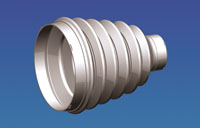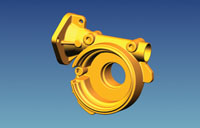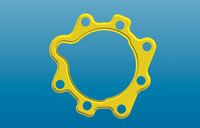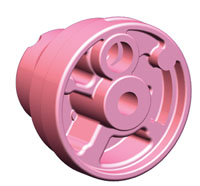Latest News
October 1, 2004
By Michael Richardson and David Prawel
The first in a series of articles discussing how development of new methodologies offers advantages over technology-based innovation; a critical approach in an increasingly competitive environment.
Fierce global competition is driving new product development at an unprecedented rate. A manufacturer’s ability to quickly test new ideas and identify new technologies is often the key to success. At the same time, products are more complex than ever and suppliers of key subsystems are spread around the globe. Because globalization is becoming more commonplace, companies find it increasingly difficult to compete based on price. As a result, the pressure is on to add value in quality and product design.
|
|
|
|

Delphi Corporation of Troy, Michigan, a developer of automotive electronics and components systems, decided to do something about that pressure. Management understood that successful companies have always recognized their key business drivers: increasing the customer value of their product, accelerating time-to-market, increasing efficiency, and improving the productivity of people and processes. Increasing customer value requires a keen understanding of the value chain to gain insight into cost, quality, and functionality—all of which help to reduce costs and enable product launches with conforming products. Accelerating time-to-market boils down to faster product cycle times, faster iterations of trial-and-error cycles, and faster convergence to winning product designs. Better efficiency and productivity means doing more with existing tools, while improving processes in order to minimize errors. It means communicating and collaborating more efficiently and making people and technology more effective. To win, you must be more innovative than your competition.
To achieve that, Delphi’s managers knew some things had to change. Historically, the company’s CAD designers faced problems when using their CAD system the way they were taught by CAD vendors. Global communication and collaboration was not only difficult, it was impossible. CAD files created by product designers could not be edited without losing data, reusing designs was nearly impossible, and productivity suffered. Designers were spending time fixing broken CAD files instead of innovating, never mind analyzing and simulating their designs. Delphi needed to find a better way for designers to work concurrently on a global basis. And because CAD and CAM systems form the heart of what Delphi does, the solution started there.
Delphi recognized that in today’s competitive market, they couldn’t afford to let their business processes operate as islands of automation. The ability to integrate people, information, and processes across the global enterprise has proven fundamental for effective business, so Delphi put together a team of experienced engineers and designers at Delphi’s Saginaw Steering division to develop a set of standardized best practices.
Company managers recognized it’s not all about technology. They took to heart Intel Chairman Andy Grove’s statement in an August 2003 Fortune interview: “Strategic actions with profound consequences are not caused only by technology-based innovations. Some of the most profound come from process innovation.”
Two New MethodologiesBy simply changing the way designers use their existing CAD systems, team members ended up defining two distinct series of process. They call them horizontal modeling (HM) and digital process design (DPD)—standardized, structured methodologies that significantly lower product and process design costs throughout the design-to-manufacturing cycle. Once they verified the methods through testing on thousands of product designs, these pioneers taught others at Delphi, and the revolution had begun. Since that time, HM and DPD have proven effective in a wide variety of real-world designs. (In part two of this series, the writers dig into the team’s process for arriving at the new methodologies.—DE)
HM and DPD are methodologies, not new software technology. HM produces higher quality CAD data that is easier to change and much more usable in downstream functions; DPD enables the rapid creation of master process models and fully associated process sheets, and keeps everything updated as design changes occur. Together, these methodologies enable controlled, instant design change propagation throughout the global enterprise. Similar to other structured methodologies, such as Six Sigma and Lean Manufacturing, these forward-thinking design methods are industry-tested and proven to shorten design cycles and lead times, reduce waste, elimi- nate rework, and dramatically accelerate time-to-market.
“Initially, we experienced some resistance to use of these methods by highly experienced designers,” says David Lien, manager of engineering services at Saginaw Steering. “We often heard ‘I know that’ or ‘I’ve done that.’ Once everyone realized the huge benefits of a standardized methodology that incorporated their good ideas and many others they hadn’t considered, our designers will never go back to the old way.”
Now CAD systems function as critical tools, contributing to core product processes and, ultimately, to Delphi’s overall efficiency. These allow design and manufacturing engineers to share 3D CAD models globally without fear that changing designs or manufacturing processes will cause costly rework.
Tracking ImprovementsFor Delphi, implementation of standardized CAD best practices produced a quantum improvement in communication and collaboration. Since designers use the same methods for creating CAD models, CAD data becomes usable by everyone in the global network. As a result, designers can more easily recognize another’s design intent and contribute more broadly to other projects. It offers a new level of staff flexibility and more projects can be completed in less time with a reduction in outsourcing. CAD designs can be changed and stored, allowing manufacturing engineers in far-flung locations to access the changes and complete their designs confident the CAD data will be usable. And, it means product designers can be more creative because they don’t have to be concerned about how or where a product is manufactured.
More than a dozen Delphi plants around the world, which produced more than 3,000 products in 2004, are now using these methods. Delphi has documented enormous benefits accrued from standardization and implementation of these new methodologies.
Engineers kept track of the process of developing several typical products developed at Saginaw Steering (see Table 1, above). Designers measured significant savings in time and accelerated product design cycles made possible by the ability to make more changes to designs faster.
According to the director of a 12-person design team at Delphi, a recent project would have required six to eight additional designers if it were done the old way. And, in another key measure of designer productivity and design reuse, a typical CAD designer now supports 30 percent more product and process designers than two years ago. This means more products can be designed faster with the same team, saving money and resulting in better quality.

Table 1: The actual times required to create product and process models for several typical parts developed at Saginaw Steering. Designers measured significant time reductions and accelerated product design cycles after they were able to make more changes to designs faster.
Over the last three years, Saginaw Steering has won two PACE awards; one for its Quadrasteer product and one for its HM and DPD methodologies. Also, for the second year in a row, Delphi received a top ranking on MIT’s survey of companies developing important patents (in the automotive category).
Thus after those first few critical steps when Delphi carefully reconsidered the way it had done things in the past, the company is now well under way following a path of true concurrent engineering.
Benefits of Standardized Methodologies
|
Michael Richardson is the director of engineering for Saginaw Steering, a division of Delphi; David Prawel is Delphi’s new venture specialist. You can contact them through e-mail at Desktop Engineering Feedback.
Delphi
Troy, Michigan
delphi.com
Subscribe to our FREE magazine, FREE email newsletters or both!
Latest News
About the Author
DE’s editors contribute news and new product announcements to Digital Engineering.
Press releases may be sent to them via [email protected].









